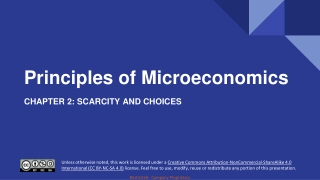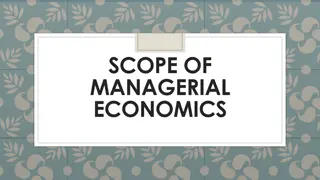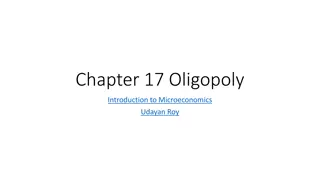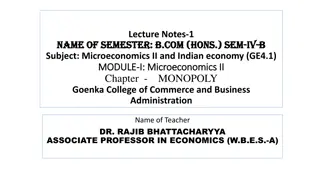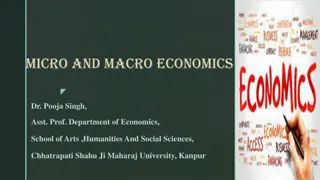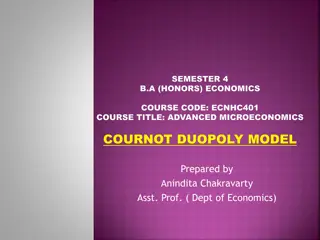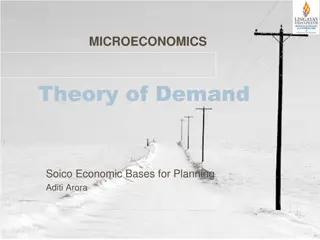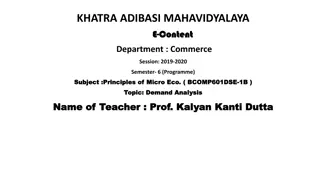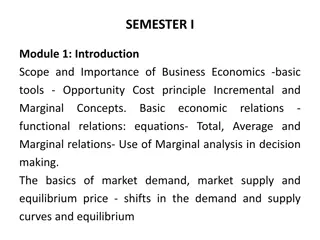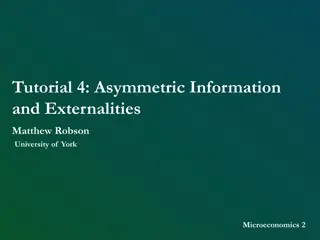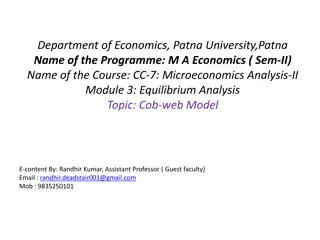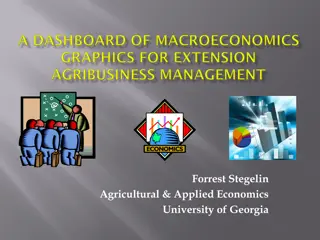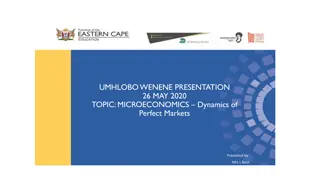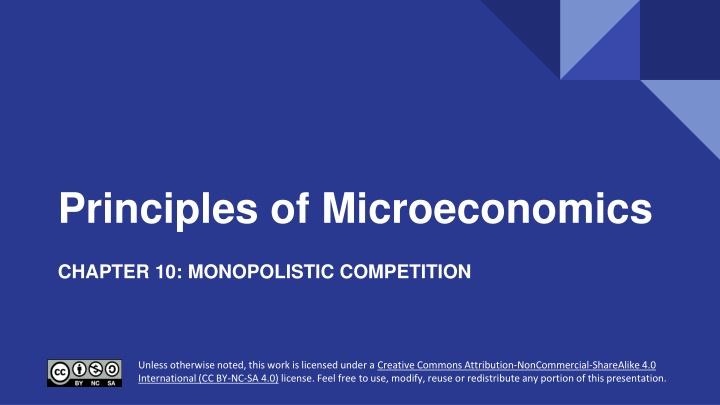
Monopolistic Competition in Economics
Learn about monopolistic competition, a market structure where multiple firms compete by offering differentiated products. Explore the key concepts of demand, marginal revenue, profit maximization, and the unique characteristics of monopolistically competitive markets. Discover how firms differentiate their products and analyze the perceived demand and pricing strategies in monopolistic competition.
Download Presentation

Please find below an Image/Link to download the presentation.
The content on the website is provided AS IS for your information and personal use only. It may not be sold, licensed, or shared on other websites without obtaining consent from the author. If you encounter any issues during the download, it is possible that the publisher has removed the file from their server.
You are allowed to download the files provided on this website for personal or commercial use, subject to the condition that they are used lawfully. All files are the property of their respective owners.
The content on the website is provided AS IS for your information and personal use only. It may not be sold, licensed, or shared on other websites without obtaining consent from the author.
E N D
Presentation Transcript
Principles of Microeconomics CHAPTER 10: MONOPOLISTIC COMPETITION Creative Commons Attribution-NonCommercial-ShareAlike 4.0 International (CC BY-NC-SA 4.0) Creative Commons Attribution-NonCommercial-ShareAlike 4.0 International (CC BY-NC-SA 4.0) Unless otherwise noted, this work is licensed under a Creative Commons Attribution-NonCommercial-ShareAlike 4.0 International (CC BY-NC-SA 4.0) license. Feel free to use, modify, reuse or redistribute any portion of this presentation.
Learning Outcomes At the end of this chapter, you will be able to: Define demand and marginal revenue Describe profit maximization in the short run long run profits Compare perfect and monopolistic competition Discuss marketing differentiated products
10.0 Monopolistic Competition Monopolistic competition lies in-between the spectrum. It involves many firms competing against each other but selling products that are distinctive in some way. Examples of monopolistic competition include: stores that sell different styles of clothing, restaurants or grocery stores that sell different kinds of food products like golf balls or beer that may be at least somewhat similar but differ in public perception because of advertising and brand names
10.1 Differentiated Products A firm can try to make its products different from those of its competitors in several ways: physical aspects of the product selling location intangible aspects of the product perceptions of the product. Products that are distinctive in one of these four ways are called differentiated products.
10.2 Perceived Demand for Monopolistic Competitor A monopolistically competitive firm faces a demand for its goods that is between monopoly and perfect competition.
10.3 Monopolistic Competition Price & Quantity Rogers faces a downward sloping demand curve and has ATC and MC curves similar to the ones we have seen before. The profit maximizing price is $70 and the profit maximizing quantity is 3.6 million subscribers.
10.4 Mark-up and Excess Capacity The marginal cost of offering the 3.6 millionth subscription is $40 for Rogers. Difference between price and the marginal cost at the profit maximizing quantity is called mark up. The mark up in the graph is $70 $40 = $30. This difference between profit maximizing quantity of output and the minimum efficient scale is the excess capacity, shown in the graph as1.3 million subscriptions.
10.5 Inefficiency of Monopolistic Competition The graph in the previous slide confirms monopolistic competition is inefficient because the producer is not producing at the minimum average total cost, rather serves 3.6 million customers which is much less than the efficient quantity of 4.9 million subscribers, unlike a producer under perfect competition. Under perfect competition, profit maximization takes place at minimum ATC, while under monopoly (Ch 9) or monopolistic competition, profit maximization takes place at below ATC.
10.6 Monopolistic Competitors and Entry Consider the profits of Rogers at the quantity of 3.6 million subscribers, shown by the green rectangle in the graph. This is the profit earned in the short run.
10.5 Monopolistic Competitors and Entry When will this shifting stop? When profits are 0. As long as P > ATC firms will continue to enter the market, and demand will continue to shift inward. As shown in this figure , this occurs when P = ATC and MR = MC. Therefore, positive profit in the short run falls to zero economic profit in the long run, due to entry by competitors.
10.6 The Benefits of Variety (Product Differentiation) Even though monopolistic competition does not provide efficiency, it does have benefits of its own. Product differentiation is based on variety and innovation. Many people would prefer to live in an economy with many kinds of clothes, foods, and car styles; not in a world of perfect competition where everyone will always wear blue jeans and white shirts, eat only spaghetti with plain red sauce, and drive an identical model of car.
10.7 Types of Market Structure Summary Market Type Description MR vs P P vs MC LR Profit LR ATC DWL Perfect Competition Many sellers, identical goods, free entry in LR MR=P P=MC Profits are zero ATCLR=ATC MIN No Monopoly Single seller, barriers to entry MR<P P>MC Positive profits ATCLR>ATC MIN Yes Monopolistic Competition Many sellers, differentiated products, free entry in LR MR<P P>MC Profits are zero ATCLR>ATC MIN Yes
10.8 KEY TERMS Demand Curve Differentiated Products Market Price Monopolistic Competition Perfectly elastic Product differentiation

